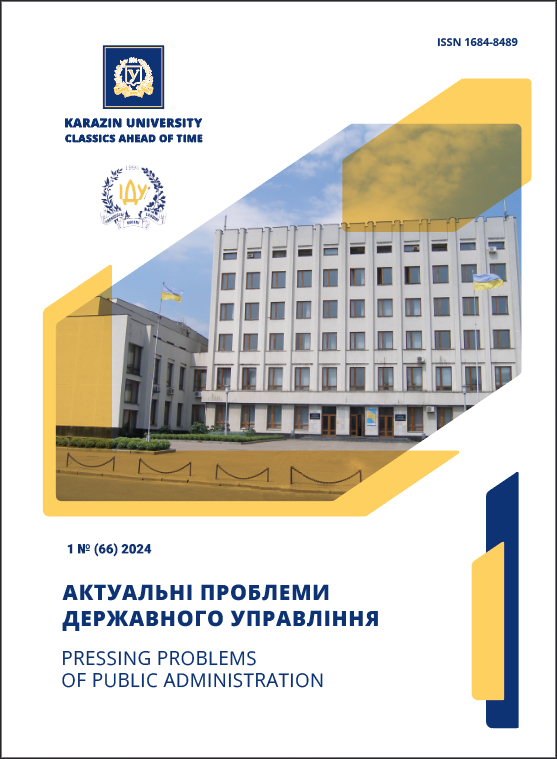Ентропія як виклик інституційній стійкості публічного управління в умовах гібридних загроз
Анотація
У статті здійснено міждисциплінарний теоретичний аналіз феномену інституційної ентропії як одного з ключових викликів інституційній стійкості системи публічного управління в сучасних умовах гібридних загроз. Запропоновано концептуалізацію інституційної ентропії як міри дезорганізації, хаотичності та зниження ефективності функціонування державних інституцій. Висвітлено історичну та теоретичну еволюцію поняття «ентропія» – від фізики й теорії інформації до його застосування в соціальних та управлінських науках. Особлива увага приділена адаптації системного та інформаційного підходів до аналізу стану інституцій публічного управління.
У межах дослідження ідентифіковано комплекс внутрішніх (ендогенних) та зовнішніх (екзогенних) чинників, що провокують зростання інституційної ентропії, зокрема: бюрократизація, корупція, організаційна інертність, відсутність стратегічного бачення, низька інституційна спроможність, інформаційні та кіберзагрози, дезінформація, політична турбулентність і зовнішній тиск. На основі порівняльного аналізу міжнародного досвіду (країн ЄС, США, України) проаналізовано приклади деструктивних впливів на інституції та механізми реагування на зростання ентропійних тенденцій.
Окрему увагу приділено обґрунтуванню можливостей виявлення та моніторингу інституційної ентропії за допомогою якісних і кількісних індикаторів, таких як індекси ефективності урядування, довіри до інституцій, структурної складності, корупції та інформаційної невизначеності. Запропоновано авторську концептуальну модель оцінки рівня інституційної ентропії з перспективою подальшої емпіричної верифікації.
У висновках доведено, що ефективне управління інституційною ентропією є ключовим чинником забезпечення стійкості, прогнозованості та легітимності системи публічного управління в періоди кризи, трансформації та загроз. Особливої актуальності це набуває в контексті українського досвіду опору гібридній агресії. Підкреслено необхідність розвитку адаптивного управління, прозорості, стратегічної комунікації та залучення громадянського суспільства як основних інструментів зниження ентропії і посилення інституційної стійкості.
Завантаження
Посилання
Alhajjar, E. (2024). Navigating the Landscape of Misinformation and Disinformation. New America; Future Security. Retrieved from https://d1y8sb8igg2f8e.cloudfront.net/documents/Navigating_the_Landscape_of_Misinformation_and_Disinformation_2024-10-28_15263_CEvoAWu.pdf.
Bailey, K.D. (2006). Living systems theory and social entropy theory. Systems Research and Behavioral Science. Retrieved from https://doi.org/10.1002/sres.728.
Bertalanffy, L. von. (1950). The Theory of Open Systems in Physics and Biology. Science, 111(2872), 23–29. Retrieved from https://doi.org/10.1126/science.111.2872.23.
Blikhar, M., Lukianova, H., Skochylias-Pavliv, O., & Vinichuk, M. (2024). Institutional stability of public administration: the economic and legal dimension. Naukovyi Visnyk Natsionalnoho Hirnychoho Universytetu, (2). Retrieved from https://dspace.lvduvs.edu.ua/handle/1234567890/7682.
Hybrid CoE. (2024). Building resilience to hybrid threats: Best practices in the Nordics (Working Paper 31). Retrieved from https://www.hybridcoe.fi/wp-content/uploads/2024/05/20240527-Hybrid-CoE-Working-Paper-31-Building-resilience-to-hybrid-threats-WEB.pdf.
Chappella, D., & Gregory, D.T. (2014). Defining the Entropy of Hierarchical Organizations. Complexity, Governance & Networks, 41–56. Retrieved from https://pdfs.semanticscholar.org/8655/f1d23285639d5833ff4fa0ea4632856011cf.pdf.
Dębski, S.S. (2025). Social Entropy and the Need for Change in Public Administration. Security Pace. Retrieved from https://www.academia.edu/127570517/SOCIAL_ENTROPY_AND_THE_NEED_FOR_CHANGE_IN_PUBLIC_ADMINISTRATION.
The Basics Guide. (2023). Institutional Entropy. Retrieved from https://thebasics.guide/institutional-entropy.
Karlsson, M. (n.d.). MW Group and NATO’s seven baseline requirements. MW Group. Retrieved from https://mw.group/mw-group-and-natos-seven-baseline-requirements.
Kong, W., & Marler, T. (2022). Ukraine’s Lessons for the Future of Hybrid Warfare. The National Interest. Retrieved from https://nationalinterest.org/feature/ukraines-lessons-future-hybrid-warfare-205922.
Pessali, H. (2023). Institutional Entropy. Journal of Economic Issues, 57(2), 397–406. Retrieved from https://doi.org/10.1080/00213624.2023.2200642.
Serrano, J. (2024). Disinformation is a threat to our trust ecosystem. Experts explain how to curb it. World Economic Forum. Retrieved from https://www.weforum.org/stories/2024/03/disinformation-trust-ecosystem-experts-curb-it.
Shannon, C.E. (1948). A Mathematical Theory of Communication. The Bell System Technical Journal, 27, 379–423, 623–656. Retrieved from https://people.math.harvard.edu/~ctm/home/text/others/shannon/entropy/entropy.pdf.
Zeckhauser, J.R. (2015). Mancur Olson and the Tragedy of the Unbalanced Commons. Harvard Kennedy School. Retrieved from https://scholar.harvard.edu/files/rzeckhauser/files/olson.pdf.
Bashtannyk, O.V. (2024). Instytutsionalni imperatyvy systemnoi rozbudovy natsionalnoi stiikosti derzhavy [Institutional imperatives of the systemic development of national resilience]. Dniprovskyi naukovyi chasopys publichnoho upravlinnia, psykholohii, prava, (2). Retrieved from https://doi.org/10.51547/ppp.dp.ua/2024.2.1 [In Ukrainian].
Bilokon, M.V. (2024). Hibridni zahrozy ta instytutsijna entropiia v domeni publichnoho upravlinnia [Hybrid threats and institutional entropy in the domain of public administration]. In Mizhnarodna ta natsionalna bezpeka: teoretychni i prykladni aspekty (Vol. 1, pp. 139–141). Dnipro: DDUVS. Retrieved from https://er.dduvs.edu.ua/bitstream/123456789/13790/1/54.pdf [In Ukrainian].
Zakharov, T. (2024). Pereosmyslennia kontseptu “instytutsijna spromozhnist”: ievrointehratsiinyi aspekt [Rethinking the concept of institutional capacity: the Eurointegration aspect]. Visnyk Lvivskoho Universytetu. Seriia Filosofsko-politychni studii, (55), 292–299. Retrieved from https://doi.org/10.30970/PPS.2024.55.35 [In Ukrainian].
Masik-Biesova, M.Z. (2024). Instytutsijna stiikist orhaniv derzhavnoi vlady u zabezpechenni natsionalnoi bezpeky Ukrainy [Institutional stability of public authorities in ensuring the national security of Ukraine]. Vcheni zapysky TNU imeni V.I. Vernadskoho, 35(74), 1. Retrieved from https://doi.org/10.32782/TNU-2663-6468/2024.1/21 [In Ukrainian].
Savenko, V.I., Palchyk, S.P., Kliuieva, V.V., & Pobieda, S.S. (2018). Entropiia yak proiav systemnoi i dialektychnoi sutnosti budivelnoi orhanizatsii [Entropy as a manifestation of the systemic and dialectical nature of a construction organization]. Upravlinnia rozvytkom skladnykh system, (36). Retrieved from https://urss.knuba.edu.ua/files/zbirnyk-36/24_0.pdf [In Ukrainian].
Skyba, O. (2024). Instytutsijna stiikist derzhavy yak faktor yii staloho rozvytku ta ekonomichnoi bezpeky [Institutional resilience of the state as a factor of its sustainable development and economic security]. Stalyi rozvytok ekonomiky, (3)50, 256–261. Retrieved from https://doi.org/10.32782/2308-1988/2024-50-38 [In Ukrainian].
Авторське право (c) 2025 Актуальні проблеми державного управління

Цю роботу ліцензовано за Міжнародня ліцензія Creative Commons Attribution 4.0.

